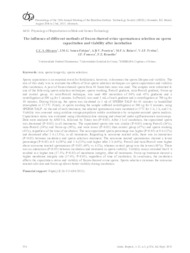The influence of different methods of frozen-thawed ovine spermatozoa selection on sperm capacitation and viability after incubation.
The influence of different methods of frozen-thawed ovine spermatozoa selection on sperm capacitation and viability after incubation.
Autoria: OLIVARES, C. C. S.; SOUZA-FABJAN, J. M. G.; PENEIRAS, A. B. V.; BALARO, M. F. A.; FREITAS, V. J. F.; FONSECA, J. F. da; BRANDÃO, F. Z.
Resumo: Abstract: Sperm capacitation is an essential event for fertilization; however, it decreases the sperm lifespan and viability. The aim of this study was to evaluate the effects of four sperm selection techniques on sperm capacitation and viability after incubation. A pool of frozen-thawed sperm from 10 Santa Inês rams was used. The samples were submitted to one of the following sperm selection techniques: sperm washing, Percoll gradient, mini-Percoll gradient, Swim-up and control group. At mini-Percoll technique, was used 400 microliters of 90% and 45% gradients and a centrifugation at 500 xg for 5 minutes. In Percoll, was used 1 mL of each gradient and a centrifugation at 700 xg for 10 minutos. During Swim-up, the sperm was incubated in 1 ml of SPERM-TALP for 45 minutos in humidified atmosphere at 37.5oC. Finaly, at sperm washing the sample suffered centrifugation at 300 xg for 8 minutes, using SPERM-TALP. At the end of each treatment, the selected spermatozoa were incubated at 37oC for 1 h, 2 h, and 3 h. Viability was assessed using acridine orange-propidium iodide combination by computer-assisted sperm analysis. Capacitation status was evaluated using chlortetracycline staining and observed under epifluorescence microscopy. Data were analyzed by ANOVA, followed by Tukey test (P<0.05). After 3 h of incubation, the capacitated sperm was decreased (P<0.05) in all treatments. The capacitated sperm rate was similar (P>0.05) among Percoll (36%), mini-Percoll (34%) and Swim-up (30%), and were lower (P<0.05) than control group (47%) and sperm washing (41%), regardless of the time of incubation. The non-capacitated sperm percentage was higher (P<0.05) at 0 h (12%) and decreased after 3 h (1.5%), in all treatments. Regarding to acrosome reacted cells, there was an interaction (P<0.05) between incubation and sperm selection treatment. The acrosome reacted spermatozoa showed a lower percentage (P<0.05) at 0 h (50%) and 1 h (53%) and higher after 3 h (64%). Percoll and mini-Percoll were higher about acrosome reacted spermatozoa (P<0.05; 60% vs. 61%), whereas control group was the lowest (49%). There was an interaction (P<0.05) between incubation and treatment in sperm viability. Viability assays revealed that 0 h resulted in a higher rate (17.5%; P<0.05) of membrane integrity, after all treatments. Swim-up treatment showed a higher membrane integrity rate (17.4%; P<0.05), regardless of time of incubation. In conclusion, the incubation affects the capacitation status and viability of frozen-thawed ovine sperm. Sperm selection increases the acrosome reacted cells rate and Swim-up allows better viability during incubation. [Influência de diferentes métodos de seleção de espermatozoides ovinos congelados sobre a capacitação e vitalidade espermática após incubação]. Resumo: Apesar de necessária para a fecundação, a capacitação espermática diminui a longevidade e vitalidade dos espermatozoides. Objetivou-se analisar os efeitos de quatro métodos de seleção espermática sobre a capacitação e vitalidade dos espermatozoides após incubação. Foi utilizado pool de sêmen congelado comercial de 10 carneiros da raça Santa Inês. As amostras foram submetidas aos diferentes métodos de seleção: lavagem por centrifugação, gradiente de Percoll, mini-Percoll, Swim-up e grupo controle. Na técnica de mini-Percoll, foi utilizado 400 microlitros dos gradientes de 90% e 45% e a amostra foi submetida a centrifugação por 5 minutos a 5000 xg. Para a técnica de Percoll, foi utilizado 1 mL de cada gradiente e os espermatozoides foram submetidos à força de 700 xg por 10 minutos. Durante o Swim-up, os espermatozoides foram incubados em 1 mL de SPERM-TALP por 45 minutos em atmosfera humidificada a 37,5oC. Já na lavagem por centrifugação, a amostra foi submetida a centrifugação por 8 minutos a 300 x g em SPERM-TALP. Posteriormente, os espermatozoides selecionados foram incubados a 37º C por 1 h, 2 h e 3 h. Foi avaliada a vitalidade por meio de iodedo de propídeo e laranja de acridina pelo sistema de avaliação seminal computadorizada. A capacitação espermática foi analisada pela coloração de hidroclorido de clortetraciclina em microscópio de epifluorescência. O efeito do método sobre os parâmetros foi avaliado pela ANOVA, seguido pelo teste de Tukey (P<0,05). Após 3 h, houve decréscimo da taxa de espermatozoides capacitados (P<0,05) em todos os métodos de seleção. Independente do momento de incubação, a taxa de capacitados foi similar (P>0,05) entre Percoll (36%), mini-Percoll (34%) e Swim-up (30%), as quais foram inferiores (P<0,05) ao grupo controle (47%) e lavagem por centrifugação (41%). A taxa de espermatozoides não capacitados foi superior (P<0,05) no momento 0 h (12%) e diminuiu após 3 h (1,5%), independentemente do método. Houve interação (P<0,05) entre intervalo de incubação e método na taxa de espermatozoides reagidos. O índice de reagidos foi menor (P<0,05) em 0 h (50%) e 1 h (53%) e maior após 3 h (64%). Percoll (60%) e mini-Percoll (61%) apres
Ano de publicação: 2015
Tipo de publicação: Resumo em anais e proceedings
Unidade: Embrapa Caprinos e Ovinos
Observações
1 - Por padrão são exibidas publicações dos últimos 20 anos. Para encontrar publicações mais antigas, configure o filtro ano de publicação, colocando o ano a partir do qual você deseja encontrar publicações. O filtro está na coluna da esquerda na busca acima.
2 - Para ler algumas publicações da Embrapa (apenas as que estão em formato ePub), é necessário ter, no celular ou computador, um desses softwares gratuitos. Sistemas Android: Google Play Livros; IOS: iBooks; Windows e Linux: software Calibre.
Acesse outras publicações
Acesse a Base de Dados da Pesquisa Agropecuária (BDPA) para consultar o acervo completo das bibliotecas da Embrapa.

